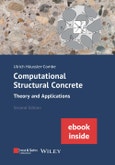Concrete is by far the most used building material due to its advantages: it is shapeable, cost-effective and available everywhere. Combined with reinforcement it provides an immense bandwidth of properties and may be customized for a huge range of purposes. Thus, concrete is the building material of the 20th century. To be the building material of the 21th century its sustainability has to move into focus. Reinforced concrete structures have to be designed expending less material whereby their load carrying potential has to be fully utilized.
Computational methods such as Finite Element Method (FEM) provide essential tools to reach the goal. In combination with experimental validation, they enable a deeper understanding of load carrying mechanisms. A more realistic estimation of ultimate and serviceability limit states can be reached compared to traditional approaches. This allows for a significantly improved utilization of construction materials and a broader horizon for innovative structural designs opens up.
However, sophisticated computational methods are usually provided as black boxes. Data is fed in, the output is accepted as it is, but an understanding of the steps in between is often rudimentary. This has the risk of misinterpretations, not to say invalid results compared to initial problem definitions. The risk is in particular high for nonlinear problems. As a composite material, reinforced concrete exhibits nonlinear behaviour in its limit states, caused by interaction of concrete and reinforcement via bond and the nonlinear properties of the components. Its cracking is a regular behaviour. The book aims to make the mechanisms of reinforced concrete transparent from the perspective of numerical methods. In this way, black boxes should also become transparent.
Appropriate methods are described for beams, plates, slabs and shells regarding quasi-statics and dynamics. Concrete creeping, temperature effects, prestressing, large displacements are treated as examples. State of the art concrete material models are presented. Both the opportunities and the pitfalls of numerical methods are shown. Theory is illustrated by a variety of examples. Most of them are performed with the ConFem software package implemented in Python and available under open-source conditions.
(incl. ebook as PDF)
Computational methods such as Finite Element Method (FEM) provide essential tools to reach the goal. In combination with experimental validation, they enable a deeper understanding of load carrying mechanisms. A more realistic estimation of ultimate and serviceability limit states can be reached compared to traditional approaches. This allows for a significantly improved utilization of construction materials and a broader horizon for innovative structural designs opens up.
However, sophisticated computational methods are usually provided as black boxes. Data is fed in, the output is accepted as it is, but an understanding of the steps in between is often rudimentary. This has the risk of misinterpretations, not to say invalid results compared to initial problem definitions. The risk is in particular high for nonlinear problems. As a composite material, reinforced concrete exhibits nonlinear behaviour in its limit states, caused by interaction of concrete and reinforcement via bond and the nonlinear properties of the components. Its cracking is a regular behaviour. The book aims to make the mechanisms of reinforced concrete transparent from the perspective of numerical methods. In this way, black boxes should also become transparent.
Appropriate methods are described for beams, plates, slabs and shells regarding quasi-statics and dynamics. Concrete creeping, temperature effects, prestressing, large displacements are treated as examples. State of the art concrete material models are presented. Both the opportunities and the pitfalls of numerical methods are shown. Theory is illustrated by a variety of examples. Most of them are performed with the ConFem software package implemented in Python and available under open-source conditions.
(incl. ebook as PDF)
Table of Contents
PrefaceNotations
List of Examples
1 INTRODUCTION
2 FINITE ELEMENTS OVERVIEW
2.1 Modeling Basics
2.2 Discretization Outline
2.3 Elements
2.4 Material Behavior
2.5 Weak Equilibrium
2.6 Spatial Discretization
2.7 Numerical Integration
2.8 Equation Solution Methods
2.9 Discretization Errors
3 UNIAXIAL STRUCTURAL CONCRETE BEHAVIOR
3.1 Uniaxial Stress-Strain Behavior of Concrete
3.2 Long-Term Behavior -
Creep and Imposed Strains
3.3 Reinforcing Steel Stress-Strain Behavior
3.4 Bond between Concrete and Reinforcement
3.5 The Smeared Crack Model
3.6 The Reinforced Tension Bar
3.7 Tension Stiffening of Reinforced Bar
4 STRUCTURAL BEAMS AND FRAMES
4.1 Cross-Sectional Behavior
4.2 Equilibrium of Beams
4.3 Finite Element Types for Plane Beams
4.4 System Building and Solution
4.5 Creep of Concrete
4.6 Temperature and Shrinkage
4.7 Tension Stiffening
4.8 Prestressing
4.9 Large Displacements -
2nd-Order Analysis
4.10 Dynamics
5 STRUT-AND-TIE MODELS
5.1 Elastic Plate Solutions
5.2 Strut-and-Tie Modeling
5.3 Solution Methods for Trusses
5.4 Rigid-Plastic Truss Models
5.5 Application Aspects
6 MULTIAXIAL CONCRETE MATERIAL BEHAVIOR
6.1 Basics
6.1.1 Continua and Scales
6.1.2 Characteristics of Concrete Behavior
6.2 Continuum Mechanics
6.3 Isotropy, Linearity, and Orthotropy
6.4 Nonlinear Material Behavior
6.5 Elastoplasticity
6.6 Damage
6.7 Damaged Elastoplasticity
6.8 The Microplane Model
6.9 General Requirements for Material Laws
7 CRACK MODELING AND REGULARIZATION
7.1 Basic Concepts of Crack Modeling
7.2 Mesh Dependency
7.3 Regularization
7.4 Multiaxial Smeared Crack Model
7.5 Gradient Methods
7.6 Discrete Crack Modeling Overview
7.7 A Strong Discontinuity Approach
8 PLATES
8.1 Lower Bound Limit Analysis
8.2 Cracked Concrete Modeling
8.3 Reinforcement and Bond
8.4 Integrated Reinforcement
8.5 Embedded Reinforcement with Flexible Bond
9 SLABS
9.1 Classification
9.2 Cross-Sectional Behavior
9.3 Equilibrium of Slabs
9.4 Reinforced Concrete Cross Sections
9.5 Slab Elements
9.6 System Building and Solution Methods
9.7 Lower Bound Limit State Analysis
9.8 Nonlinear Kirchhoff Slabs
9.9 Upper Bound Limit State Analysis
10 SHELLS
10.1 Geometry and Displacements
10.2 Deformations
10.3 Shell Stresses and Material Laws
10.4 System Building
10.5 Slabs and Beams as a Special Case
10.6 Locking
10.7 Reinforced Concrete Shells
11 RANDOMNESS AND RELIABILITY
11.1 Uncertainty and Randomness
11.2 Failure Probability
11.3 Design and Safety Factors
12 CONCLUDING REMARKS
A SOLUTION METHODS
A.1 Nonlinear Algebraic Equations
A.2 Transient Analysis
A.3 Stiffness for Linear Concrete Compression
A.4 The Arc Length Method
B MATERIAL STABILITY
C CRACK WIDTH ESTIMATION
D TRANSFORMATIONS OF COORDINATE SYSTEMS
E REGRESSION ANALYSIS
INDEX








